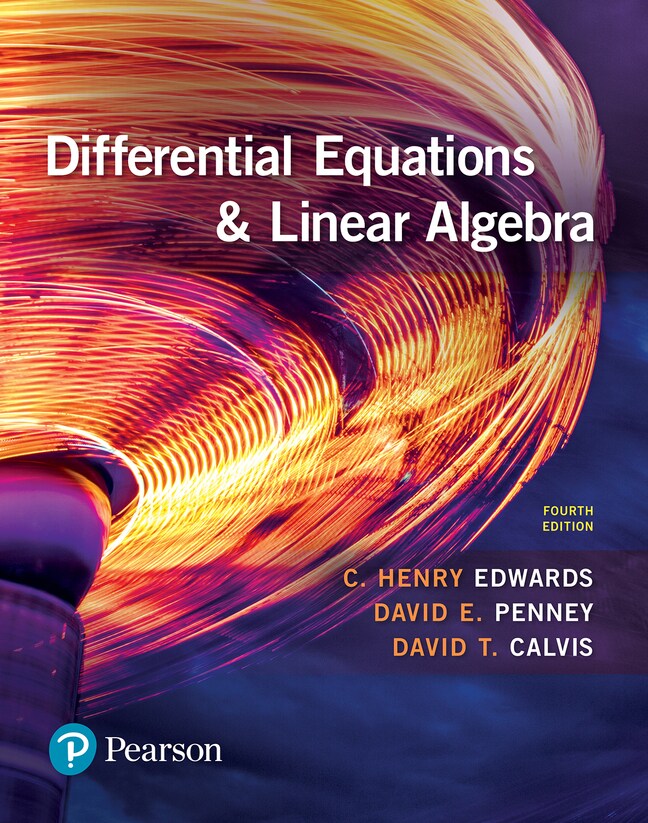
Differential Equations and Linear Algebra, 4th edition
- Henry C. Edwards
- , David E. Penney
- , David Calvis

- Watch and learn
Videos & animations bring concepts to life
- Listen on the go
Learn how you like with full eTextbook audio
- Find it fast
Quickly navigate your eTextbook with search
- Stay organized
Access all your eTextbooks in one place
- Easily continue access
Keep learning with auto-renew
Differential Equations and Linear Algebra, 4th Edition teaches the basic theory of differential equations and linear algebra while exploring a variety of realistic applications, giving you the right balance between concepts, visualization, applications and skills. It combines core topics in elementary differential equations with concepts and methods of elementary linear algebra; it provides the conceptual development and geometric visualization that is essential to science and engineering students in a modern differential equations and linear algebra course. The authors balance traditional manual methods with the computer-based methods that illuminate qualitative phenomena; this comprehensive approach makes accessible a wider range of more realistic applications.
Published by Pearson (September 1st 2020) - Copyright © 2021
ISBN-13: 9780137313617
Subject: Advanced Math
Category: Differential Equations & Linear Alg (Combined)
- First-Order Differential Equations
- 1.1 Differential Equations and Mathematical Models
- 1.2 Integrals as General and Particular Solutions
- 1.3 Slope Fields and Solution Curves
- 1.4 Separable Equations and Applications
- 1.5 Linear First-Order Equations
- 1.6 Substitution Methods and Exact Equations
- Mathematical Models and Numerical Methods
- 2.1 Population Models
- 2.2 Equilibrium Solutions and Stability
- 2.3 Acceleration - Velocity Models
- 2.4 Numerical Approximation: Euler's Method
- 2.5 A Closer Look at the Euler Method
- 2.6 The Runge - Kutta Method
- Linear Systems and Matrices
- 3.1 Introduction to Linear Systems
- 3.2 Matrices and Gaussian Elimination
- 3.3 Reduced Row-Echelon Matrices
- 3.4 Matrix Operations
- 3.5 Inverses of Matrices
- 3.6 Determinants
- 3.7 Linear Equations and Curve Fitting
- Vector Spaces
- 4.1 The Vector Space R3
- 4.2 The Vector Space Rn and Subspaces
- 4.3 Linear Combinations and Independence of Vectors
- 4.4 Bases and Dimension for Vector Spaces
- 4.5 Row and Column Spaces
- 4.6 Orthogonal Vectors in Rn
- 4.7 General Vector Spaces
- Higher-Order Linear Differential Equations
- 5.1 Introduction: Second-Order Linear Equations
- 5.2 General Solutions of Linear Equations
- 5.3 Homogeneous Equations with Constant Coefficients
- 5.4 Mechanical Vibrations
- 5.5 Nonhomogeneous Equations and Undetermined Coefficients
- 5.6 Forced Oscillations and Resonance
- Eigenvalues and Eigenvectors
- 6.1 Introduction to Eigenvalues
- 6.2 Diagonalization of Matrices
- 6.3 Applications Involving Powers of Matrices
- Linear Systems of Differential Equations
- 7.1 First-Order Systems and Applications
- 7.2 Matrices and Linear Systems
- 7.3 The Eigenvalue Method for Linear Systems
- 7.4 A Gallery of Solution Curves of Linear Systems
- 7.5 Second-Order Systems and Mechanical Applications
- 7.6 Multiple Eigenvalue Solutions
- 7.7 Numerical Methods for Systems
- Matrix Exponential Methods
- 8.1 Matrix Exponentials and Linear Systems
- 8.2 Nonhomogeneous Linear Systems
- 8.3 Spectral Decomposition Methods
- Nonlinear Systems and Phenomena
- 9.1 Stability and the Phase Plane
- 9.2 Linear and Almost Linear Systems
- 9.3 Ecological Models: Predators and Competitors
- 9.4 Nonlinear Mechanical Systems
- Laplace Transform Methods
- 10.1 Laplace Transforms and Inverse Transforms
- 10.2 Transformation of Initial Value Problems
- 10.3 Translation and Partial Fractions
- 10.4 Derivatives, Integrals, and Products of Transforms
- 10.5 Periodic and Piecewise Continuous Input Functions
- Power Series Methods
- 11.1 Introduction and Review of Power Series
- 11.2 Power Series Solutions
- 11.3 Frobenius Series Solutions
- 11.4 Bessel Functions
Appendices
- A: Existence and Uniqueness of Solutions
- B: Theory of Determinants
APPLICATION MODULES
The modules listed below follow the indicated sections in the text. Most provide computing projects that illustrate the corresponding text sections. Many of these modules are enhanced by the supplementary material found at the new Expanded Applications website.
- 1.3 Computer-Generated Slope Fields and Solution Curves
- 1.4 The Logistic Equation
- 1.5 Indoor Temperature Oscillations
- 1.6 Computer Algebra Solutions
- 2.1 Logistic Modeling of Population Data
- 2.3 Rocket Propulsion
- 2.4 Implementing Euler's Method
- 2.5 Improved Euler Implementation
- 2.6 Runge-Kutta Implementation
- 3.2 Automated Row Operations
- 3.3 Automated Row Reduction
- 3.5 Automated Solution of Linear Systems
- 5.1 Plotting Second-Order Solution Families
- 5.2 Plotting Third-Order Solution Families
- 5.3 Approximate Solutions of Linear Equations
- 5.5 Automated Variation of Parameters
- 5.6 Forced Vibrations and Resonance
- 7.1 Gravitation and Kepler's Laws of Planetary Motion
- 7.3 Automatic Calculation of Eigenvalues and Eigenvectors
- 7.4 Dynamic Phase Plane Graphics
- 7.5 Earthquake-Induced Vibrations of Multistory Buildings
- 7.6 Defective Eigenvalues and Generalized Eigenvectors
- 7.7 Comets and Spacecraft
- 8.1 Automated Matrix Exponential Solutions
- 8.2 Automated Variation of Parameters
- 9.1 Phase Portraits and First-Order Equations
- 9.2 Phase Portraits of Almost Linear Systems
- 9.3 Your Own Wildlife Conservation Preserve
- 9.4 The Rayleigh and van der Pol Equations